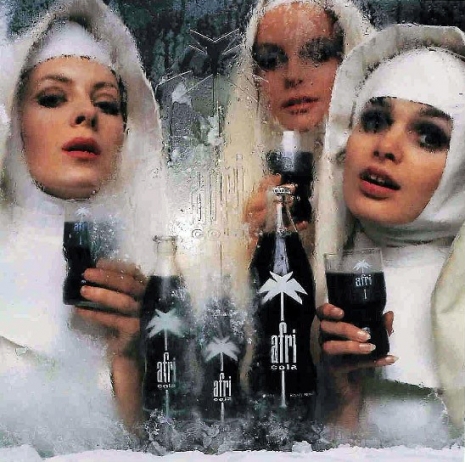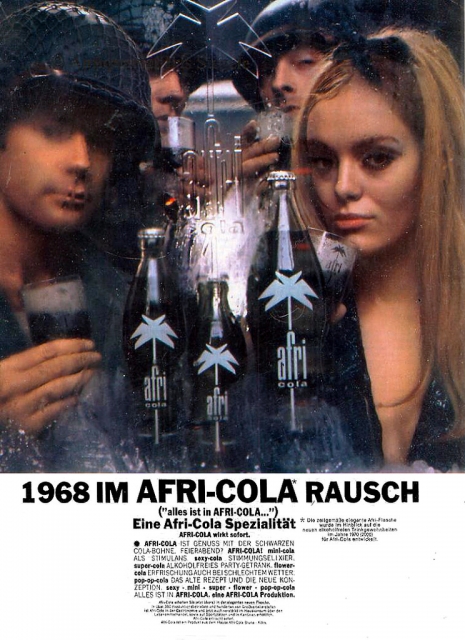
In the 1960s, German soft drink Afri-Cola (which first hit the shelves in 1931) was quickly losing to its competitors Coca-Cola and Pepsi. In 1968, the brand started searching for a new marketing campaign in an attempt to regain their image. They hired prolific commercial designer and photographer Charles Wilp from Düsseldorf. The wildly eccentric 36-year-old was rarely seen not wearing his trademark canary yellow jumpsuit and his provocative ideas that knew no creative limits would soon elevate him to a pop star level.
While visiting the Marshall Space Center in Huntsville, Alabama, Wilp looked into the “Cryo Chamber,” (a tent where rockets are inspected at below zero temperatures), and through various iced plastic films saw a folding door with the image of a pin-up girl. He began envisioning the playmate floating around the room as if she were a ghost, and this gave birth to his groundbreaking ad concept.

Approximately 20 deliberately taboo TV spots and print ads with surreal-futuristic images began running all over Germany. These bizarre visuals included attractive nuns wearing makeup and eyeliner, lascivious stewardesses administering transfusions with cola instead of blood, an American soldier with a dove of peace, and a nude mustachioed male (the very first nudity in advertising history) weightlifting a soft drink bottle. Wilp’s risque ads, aimed to make viewers feel intoxicated without the use of drugs, were met with furious protest from ecclesiastical moralists who unintentionally helped the brand achieve exactly what they wanted: Afri-Cola became the cult drink of the flower power generation overnight and sales increased by a remarkable 30 percent.
Charles Wilp achieved this success by rejecting ad agency tools such as market research and media planning. Instead, he moved forward with his own strategy based on reversing visual perception. “If, for example, the market researchers say Afri-Cola is for young people, smiling young people should appear on the display. And if the media planners say Afri-Cola is a drink for hot days, then the ad should be in the magazines in the summer. I do the opposite: I photograph Afri-Cola with nuns and connect that with intoxication. I do not take a man with two girls, which would be common, but a girl with two men.” The breakthrough ads featured representatives of all different races, sexes, and levels of social strata.

Originally, Charles Wilp hired German-based American garage rock band The Monks to record a jingle, he thought their experimental sound and blasphemous image that mimicked the Catholic church would be a perfect fit for the controversial advertising campaign. Unfortunately, his plan didn’t work out. “The musicologists and the CEO couldn’t agree with me and the whole thing failed.” Charles Wilp explained in the 2008 Monks documentary The Transatlanic Feedback. “I performed my Afri-Cola music with 48 strings, 2 oboes, 2 harps, 4 timpani, classical instruments. And I created this ‘unreal’ sound which I always wanted to do and which I could have achieved faster with The Monks. Then I didn’t have to deal with the burden of conventions.” Wilp’s orchestrated Afri-Cola score was released on vinyl as a “super single.”
Above the music, a distorted voice-over announces that Afri-Cola is “Menschen, die bewusst ihre Zeit genießen - bei vollem Verstand” (For people who consciously enjoy their time… with full understanding). The slogans on other ads boasted “The Earth is a paradise with Afri-Cola,” “Afri-Cola is sex over the clouds,” and “The Super-cola alcohol-free party drink.” Amongst the many models who posed behind the ice crystals were Marsha Hunt from the London production of the rock musical Hair (who was also the inspiration for the Rolling Stones hit “Brown Sugar”). Wilp used the ads to help launch the career of 20-year-old Donna Summer who had recently accepted the role of Sheila in the Munich production of Hair, she later became a disco queen and one of the best-selling artists of all time.

Charles Wilp quoted philosophical writer Robert Musil by saying “The new art arises wherever one does not suspect it,” and believed that a bright future waits for us in outer space where traditional art will no longer be an issue. Wilp wanted to be the first “ARTronaut” of space and art history and lived his dream wearing a yellow jumpsuit every single day because of its resemblance to the orange suits worn by astronauts. In 1995 Wilps fantasy turned into a reality when he became the first artist to paint at an altitude of 40,000 feet on board a European Space Agency training mission.
As for Afri-Cola, after temporarily changing the recipe in the ‘90s to appeal to the caffeinated up-all-night techno crowd, the drink returned to its original taste again in 2006. So the next time you’re in Germany, don’t forget to experience the original “Super-sexy-mini-flower-pop-op” soft drink.

